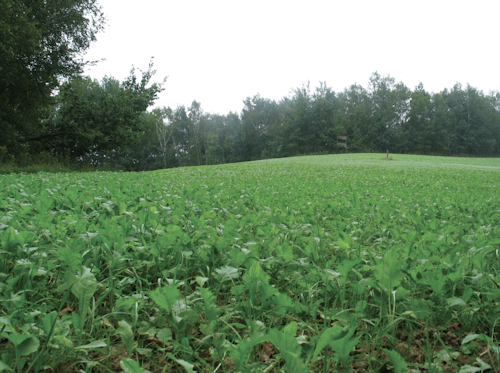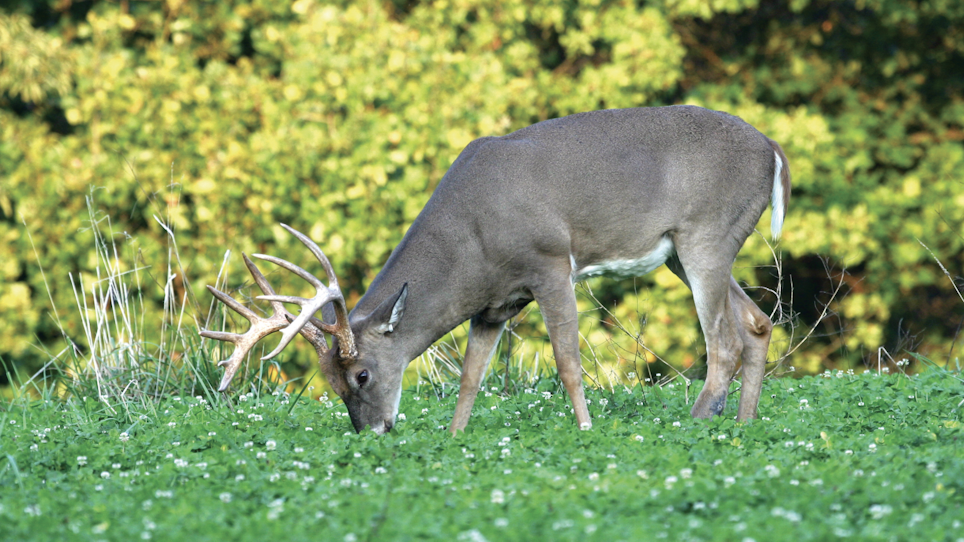If you’ve recently acquired hunting property — whether by leasing or ownership — then you probably plan to improve that property’s whitetail-hunting potential. The obvious way is to cultivate food plots. Plant them, and deer will call your property “home.” If only it were so simple.
Planting food plots certainly improves whitetail habitat. It’s a given that the more food your property offers, the more deer it will attract. However, providing resident whitetails with enough resources — food at the top of the list — so they don’t need to leave your property is more complex. You must understand that food sources shift with seasons. For example, clover alone won’t hold deer on your property 365 days a year. Thus, it’s crucial to expand and offer food deer will eat as seasons shift. Only then will you hold resident deer on your property, provided that your property also offers cover and water.
Before you plan your 2019 food plots, let’s review insights from a couple of experts as to which types of food to offer with respect to shifting seasons.
Spring and Summer Nutrition
Jon Cooner of Whitetail Institute knows whitetail food sources. “Most important when planning your food plots is considering the nutrients that are most critical during specific times of the year,” he said. “A good rule of thumb in most regions is to plant 50 to 60 percent of your plots in perennials, the remaining 40 to 50 percent in annuals.
“Protein is king from late spring to early fall,” Cooner continued. “This is when bucks are building their antlers and body mass, and protein helps them do it. All perennials in our line are high in protein. In particular, Imperial Whitetail Clover is by far the most popular. It’s packed with protein, tolerates cold (perfect for northern climates) and is drought- and disease-resistant. Another notable option is the Imperial Whitetail Chic Magnet forage chicory. It provides up to 44 percent of antler-building protein.”
“On the annual side, Power Plant is a high-protein spring and summer option. The remaining Whitetail Institute annuals, however, are mostly high in carbohydrates and make better fall and winter forage,” Conner added.”

Native Foods and Fruit Trees
“Obviously, deer will find and feed on native food sources, such as acorns and apples,” Cooner shared. “Oak and apple trees can be fertilized to boost production, which is an inexpensive way to improve your property’s natural food offerings.”
Jeff Helmers, owner of Big Rack Trophy Products and Big Rack Whitetail Academy, believes fruit trees are imperative to whitetail nutrition. “Folks should really have several varieties of fruit trees on their properties,” he states. “The intent is to have fruit dropping throughout all stages of the season. If you plant multiple fruit trees of only one variety, guess what, deer will stop feeding there once the final apple hits the ground.
“Personally, I have eight different types of apple trees on my property,” Helmers continued. “Some of my trees hold their apples into December. As well, I have eight different types of pear trees. Through some extensive trial and error, I also found a persimmon variety that withstands the northern climate here in Wisconsin.”
Whitetails are survivors, meaning they can and have lived off the land since long before food plotting became popular. For that reason, Cooner believes that food plots should be considered a supplement to native foods on a given property. “Deer aren’t going to solely live off of food plots,” he stated. “They’ll eat underneath apple and oak trees during the dropping seasons. But, when apples and acorns aren’t present, they’ll move if you don’t have alternating food sources such as clover, corn, rape, turnips and soybeans on your property.”
Fall and Winter Annuals
As Cooner mentioned earlier, annuals are an integral part of an effective food program. “In our line, Imperial Whitetail Winter-Greens and Oats Plus are two viable annuals that provide high-carb forage for the latter part of the season and well into winter,” he said.
In terms of fall and winter forage, Helmers also suggests carb-rich annuals. “Rape, turnips and radishes are solid fall food sources,” he suggested. “But, I don’t like to plant just one or two of these. Blends are so much more effective. For example, my Big Rack Trophy Products Fall/Winter Extreme blend offers a mix of fall and winter forage. There’s objective behind blends. The buckwheat sprouts and grows first, and the deer eat it first. Then, the rape and turnips come up, which are obviously preferred later in the fall. And, there are perennial clovers in there that’ll come back the following year, providing spring and summer forage.”
Mapping Food on Your Property
“In terms of performance, it’s rare to find one seed blend that does everything,” Cooner said, “which is why it’s important to offer a generous mix of both annuals and perennials to supplement native foods. Each property is a little bit different, so it’s also important to test different varieties to find the optimum ratio that holds the most deer on your property,” he added.
Many hunters confuse large fields as stand locations rather than places for deer to feed and feel safe. Sure, firearm hunters can sit a couple hundred yards away from the field, creating little or no disturbance. Meanwhile, bowhunters must get within 40 yards, hopefully closer. The problem with bowhunting over large fields is predicting where deer will enter, and then exiting the stand once darkness falls, which usually alerts deer to human presence. Further, most mature bucks won’t enter large fields during shooting light.
In most cases, it's wiser to hunt deer, especially during archery season, between their bedding and main food sources. “The key is to create kill plots, small openings deer must walk through as they leave the bedding area and travel toward destination fields/plots,” Helmers said. “Once darkness falls, most deer will be at the destination food source, alleviating concerns of spooking them as you exit your kill-plot stand after unsuccessful hunts.”
Cooner agreed that kill plots are best for bowhunting ambushes. “Plant a highly attractive seed in these kill plots, foods that deer cannot resist as they head toward a main food source,” Cooner suggested. “I recommend Imperial Whitetail BowStand, although I’m sure other products in our seed line would perform equally. BowStand is easy to plant with minimal soil preparation and equipment. It consists of attractive forages and grows well in partially-shaded locations; plus, it continues producing as deer graze on it.”
Climate, Setting and Equipment Considerations
Part of the dilemma hunters face is choosing the correct seed for the climate, specific location and available equipment. Whitetail Institute simplifies the equation with its Product Selector tab at its website. It helps eliminate seeds and seed blends less than ideal for your individual situation.
As for climate, Helmers believes most food-plot seeds formulated in the north will grow somewhat well in southern climates, but seeds formulated in the south, say, Texas, just won’t withstand the punishing weather of the northern states and provinces. “I primarily conduct food-plot testing in the Midwest, so I know my seeds will withstand the cold climate,” he said. “It’s probably wise to buy seeds from a company that tests in your specific climate. Alternatively, you could do your own testing over several years to determine what works best for you.
Variety Wins
As Cooner said earlier, whitetails need different nutrients at different times of the year. Again, protein-rich food sources are the allure from spring through early fall. Then, they take the back seat to carb-rich foods as fall and winter set in.
Helmers feels the best food program is to provide variety. “I know that very few properties offer the variety mine does,” he said. “My property is only about 40 acres, but it holds deer because I’ve done the work to provide everything they need. Variety is critical. Having 17 varieties of fruit trees to complement my kill and destination food plots gives the deer so much. Think of it this way: If you offer what they need, they have no reason to leave. Have that mindset, and you can make your property the best in your area, but only if you’re willing to put in some hard work.”
BONUS: Water and Minerals
Variety isn't limited to plant and tree varieties for your food plots. Deer need water too, and the occasional mineral boost doesn't hurt either. Consider complementing food plots with water and minerals.
Create a Waterhole
Having water on your property is another step to hold deer. “There are multiple ways to add water to your hunting location,” Helmers shared. “Of course, you can dig a large pond with heavy equipment, but I prefer not to because it becomes basically a permanent fixture. You cannot move or tweak it.
“My first water source was a 50-gallon tank I bought from a hardware store,” he continued. “The problem was that it would go bone-dry every six days. It just wasn’t practical. So, I bought a 160-gallon tank, which is about five times larger in circumference than the 50-gallon one. The wider opening gathers more rainfall. In 10 years, I’ve only had to add water to it one time. And the way it’s set up, all deer that drink from it offer top-pin shot opportunities.”
Minerals Improve Herd Health
Like humans, deer will reach their best potential when they consume minerals and supplements throughout the year. Of course, they’ll find naturally occurring minerals the land provides. But, many supplements are sold commercially, and are proven to build impressive antlers and boost herd health.
“We’re very conservative as to what we call ‘nutritional minerals and supplements,’” Cooner shared. “Many commercial ‘mineral’ products are just glorified salt. Companies toss a fancy name on it and market it as a ‘mineral’ or ‘supplement.’ Again, we’re very careful about this, and we denote our low-nutrient products as attractants. As you shop for supplements, be sure to read labels. Less salt and more calcium and phosphorus, such as that found in our 30-06 Mineral/Vitamin Supplement, will improve antler growth and overall herd health.
“That specific product is designed for spring and summer,” Cooner continued. “In 2018, we added a fall/winter complement to the 30-06 line with the 30-06 Thrive. And, we also have the 30-06 Plus Protein, which is another spring and summer blend.
“Lots of folks feed vitamins and minerals only during antler-growing season,” Cooner added. “However, it’s equally important to feed them all throughout the winter so that bucks can stay healthy after the rut, allowing a more fluid transition from winter survival to spring and summer antler development.”
In any case, providing these necessary minerals and vitamins all year long is just another step toward creating resident deer on your property. Note: Before you place loose supplements or those in block form on your property, be sure to study your state’s or province’s baiting/feeding regulations.






